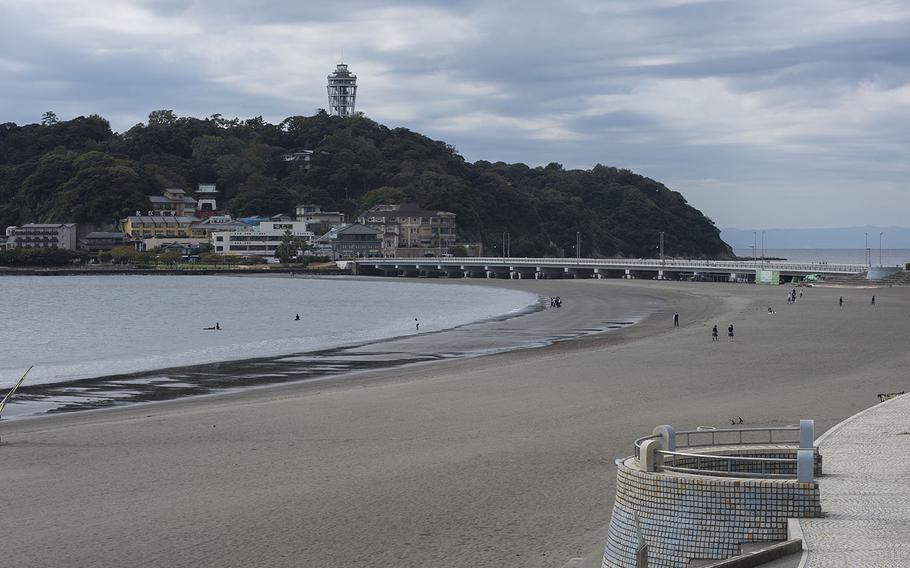
Enoshima is near Shonan beach, a trendy summer destination for surfers and vacationers from Kanagawa prefecture, nearby Tokyo and farther afield. (Akifumi Ishikawa/Stars and Stripes)
A small island off the coast of Japan’s Kanagawa prefecture, laden with historic shrines, expansive views and a landmark tower, makes for a great day trip at any time of year.
Enoshima is near Shonan beach, a trendy summer destination for surfers and vacationers from Kanagawa prefecture, Tokyo and farther afield. The island itself is about 2 ½ miles around and studded with old shrines, an observation tower with a great view of Mount Fuji and beach walkways that face the setting sun.
The island’s history reaches to the 9th century, when influential Buddhist monks Kukai and Nichiren trained there; through the 12th century, when Minamoto no Yoritomo, founder of the Kamakura Shogunate, prayed there for victory in battle; and into the early 20th century, when Enoshima’s shrines became popular with the devout, according to the Fujisawa city website.
Visitors may reach the island via the 425-yard-long Benten-bashi bridge, which was built when a harbor was developed in Enoshima for the 1964 Tokyo Olympics’ yacht race, according to the Kanagawa Prefectural Office website.
Across the bridge, a bronze torii gate marks the opening to Benzaiten Nakamise, a street filled with souvenir shops, restaurants and traditional Japanese inns.
Some visitors stop here for local specialties: grilled scallops, squid and Enoshima beer. This is the major shopping street but there are shops and restaurants scattered throughout the island.
The Enoshima escar, or escalator, takes visitors to an observation area atop a small hill, for a fee. Those inclined to fitness can walk the 200-some stone steps to the top, instead. Along the way, they’ll find more shrines, shops and restaurants.
The escar carries visitors to the top in about four minutes, with stops along the way at various shrines. The ride costs 360 yen, about $3.50, for adults and 180 yen, about $1.75, for children.
Enoshima Shrine is one of the major shrines on the island. It was first built in 552 at Iwaya, also on Enoshima, by order of Emperor Kinmei, according to the Fujisawa city website. The current shrine is made up of three shrines called Hetsunomiya, Nakatsunomiya and Okutusnomiya.
Hetsunomiya has a pond with statue of dragon that is said to bestow luck on visitors who wash their coins in the water.
Nearby is the Enoshima Sea Candle, a lighthouse and observation tower, inside Samuel Cocking Garden, which was named after a Meiji-period British trader.
Entrance to the garden costs 200 yen for adults and 100 yen for children. The garden’s highlights include 250 strains of around 500 camellia flowers from January to March. From May to October are crimson roses from Canada, according to the Kanagawa prefecture website.
The Enoshima Sea Candle stands 380 feet above sea level, where it offers a panoramic view of Sagami Bay. Admission is 500 yen for adults and 250 yen for children.
On clear days, visitors may enjoy views of Mount Fuji, Yokohama Landmark Tower and Izu Oshima islands. The tower is illuminated between Nov. 11 and March 7 and is said to be one of the three major illuminations in the Kanto region.
After enjoying the great view, visitors can take steps down to the other side of the island to enjoy more beautiful views of the ocean and caves.
On the island’s southwest side is Chigogafuchi, a marine plateau famous for rock fishing and views of the sun setting behind Mount Fuji. During low tide, visitors can find fish and crabs under the rocks.
A walk along the cliff from Chigogafuchi brings visitors to Iwaya Caves, created by eons of tidal erosion.
There are two caves, one 500 feet deep and the other 183 feet deep, that were long considered sacred sites where worshippers gathered. Today, they hold exhibits on the history and culture of Enoshima and cost 500 yen for high school students and older and 200 yen for junior and elementary school children.
A popular site for couples is Ryuren no Kane, or The Bell of the Dragon’s Love. It is said that couples enjoy eternal love if they ring the bell together and then attach a padlock bearing their names to the nearby fence.
Visiting all these tourist spots will take the whole day, but if you have more time, the Enoshima Aquarium near Katase-Enoshima station is a great sightseeing spot as well. It offers dolphin shows and a jellyfish display, which is said to be one of the best displays of jellyfish in the world.
kusumoto.hana@stripes.com Twitter: @HanaKusumoto
Directions: The bridge to the island is walking distance from Katase-Enoshima station on Odakyu Electric Railway, Enoshima station on Enoshima Electric Railway (or Enoden) and Shonan-Enoshima station on Shonan Monorail.
Costs: Most of the sightseeing spots have entrance fees. A discounted ticket, called an Eno-pass, includes admission to the Enoshima escar, Samuel Cocking garden, Enoshima Sea Candle and Iwaya caves. The pass costs 1,000 yen for adults and 500 yen for children and is available at the first escalator of the Enoshima escar, the Katase-Enoshima tourist information center or Fujisawa city tourism center.
Food: Restaurants and cafes are available throughout the island.
Information: Online: discover-fujisawa.jp